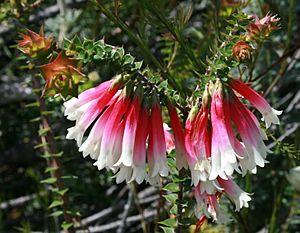Fuchsia heath facts for kids
Quick facts for kids Fuchsia heath |
|
|---|---|
 |
|
| Epacris longiflora in flower at Grotto Point Reserve, Sydney | |
| Scientific classification |
The Epacris longiflora, also known as the fuchsia heath, is a beautiful plant. It belongs to the plant family called Ericaceae. This plant is special because it is only found naturally in eastern Australia.
It's a shrub that can grow upright or spread out. It has leaves shaped like eggs with pointed tips. Its flowers are red and look like tubes, which is why it's called longiflora (meaning "long flower"). You can usually see its flowers all year round. This plant grows from the central coast of New South Wales up to southern Queensland.
Contents
What Does Fuchsia Heath Look Like?
Fuchsia heath is a shrub that can be tall or spread out wide. It usually grows to be about 50 to 200 centimeters (20 to 79 inches) high. Its stems have clear marks where old leaves used to be.
The leaves are shaped like eggs and have a pointed end. They are about 5.6 to 17 millimeters (0.2 to 0.7 inches) long and 3 to 6.6 millimeters (0.1 to 0.3 inches) wide. The leaves are thin and flat, with tiny teeth along their edges.
The Flowers
The flowers are mostly red with a white tip, but sometimes they are all red. Each flower sits on a small stalk, called a peduncle, which is up to 2 millimeters (0.08 inches) long.
The flower has five petals that are joined together to form a tube. At the end of the tube, there are five small, rounded parts called lobes. The tube itself is about 12 to 27 millimeters (0.5 to 1.1 inches) long and 5 to 6 millimeters (0.2 to 0.24 inches) wide. The lobes are about 2.4 to 4.4 millimeters (0.09 to 0.17 inches) long.
At the bottom of the petal tube, there are layers of small, leaf-like parts called bracts. There are also five green parts called sepals, which are about 4.5 to 6 millimeters (0.18 to 0.24 inches) long. Inside the flower tube, you'll find the parts needed for the plant to make seeds. These include a central stalk called a style with a sticky tip called a stigma. At its base is the ovary, where seeds develop. The stamens, which produce pollen, are hidden inside the tube.
Fuchsia heath flowers bloom throughout the year, but there are fewer flowers during the summer months. After flowering, the plant produces small, dry fruits called capsules. These capsules are about 3 to 4 millimeters (0.12 to 0.16 inches) long and hold tiny, light seeds.
Naming the Fuchsia Heath
The scientific name Epacris longiflora was first officially written down by a person named Antonio José Cavanilles in 1797. He published his description in a book called Icones et descriptiones plantarum.
The second part of its scientific name, longiflora, comes from two Latin words. Longus means "long" or "extended," and flos means "flower." So, longiflora simply means "long flower," which perfectly describes its tube-shaped blooms. One common name for this plant is "cigarette flower," because of the pattern on its flowers.
Where Does Fuchsia Heath Grow?
Fuchsia heath is found along the coast and on the tablelands (flat, high areas) of eastern Australia. Its range starts north of Berry in New South Wales and goes all the way up to south-eastern Queensland.
This plant likes to grow in sandy soil. You can often find it on cliff faces, at the edges of open heathlands (areas with small shrubs) and woodlands, and in dry sclerophyll forests (forests with tough, hard-leaved trees).
How Long Does Fuchsia Heath Live?
In the wild, fuchsia heath plants are thought to live for about 5 to 20 years.
Growing Fuchsia Heath in Gardens
Epacris longiflora is a very popular plant for gardens. It was first grown in gardens in England in 1803. It can grow in different types of soil, as long as the water drains away well. It grows best in a spot that gets some shade, not full sun all day.
It can sometimes be a bit tricky to grow and keep healthy, especially in places like the Australian National Botanic Gardens in Canberra.

